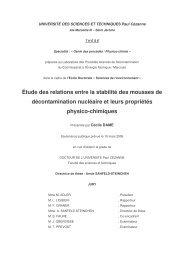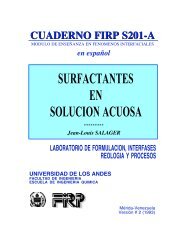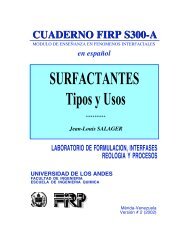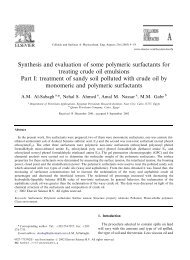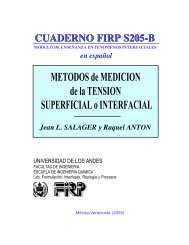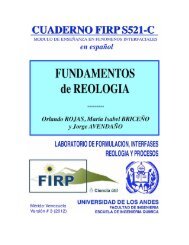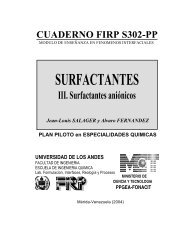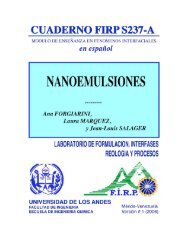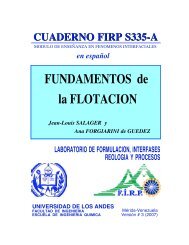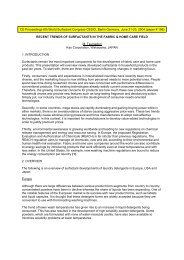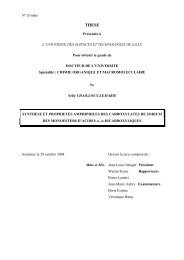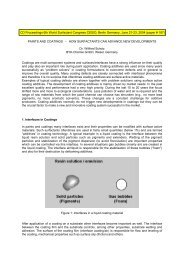Solubilization-emulsification mechanisms of detergency
Solubilization-emulsification mechanisms of detergency
Solubilization-emulsification mechanisms of detergency
You also want an ePaper? Increase the reach of your titles
YUMPU automatically turns print PDFs into web optimized ePapers that Google loves.
C.A. Miller and K.H. Raney/Colloids Surfaces A: Physicochem. Eng. Aspects 74 (1993) 169-215 195<br />
critical value ws* given by the following<br />
equation [73]<br />
w s* = w sB F 1(w oC) + w sC F 2 (w oC) (5)<br />
Here w sB and w sC are the surfactant mass<br />
fractions at the L 1 and L 2 ends <strong>of</strong> the limiting tie<br />
line forming one boundary <strong>of</strong> the two-phase<br />
region for these phases, and w oC is the oil mass<br />
fraction at the L 2 end. The quantity w sB is <strong>of</strong>ten<br />
called the "limiting association concentration"<br />
or LAC [56]. The functions F 1 and F 2 are<br />
defined as follows<br />
where D o and D s are the diffusivities <strong>of</strong> the oil<br />
and the surfactant in the L2 phase, D's is the<br />
diffusivity <strong>of</strong> the surfactant in the L1 phase and<br />
hoC is the (constant) value <strong>of</strong> the similarity<br />
parameter [x/(4D.t) 1/2 ] at the L2 end <strong>of</strong> the<br />
limiting tie line (see discussion <strong>of</strong> diffusion path<br />
analysis above).<br />
Vertical cell-contacting experiments gave<br />
results in reasonable agreement with Eq. (3) for<br />
the sodium octanoate-n-decanol-water system<br />
[73]. One might expect that <strong>detergency</strong> would<br />
be improved when the intermediate phase - in<br />
this case the lamellar liquid crystal - is formed<br />
since more <strong>of</strong> the alcohol is solubilized. Indeed,<br />
Kielman and van Steen [11] observed such<br />
behavior in the potassium octanoate-n-decanolwater<br />
system.<br />
The focus <strong>of</strong> this section is the time-dependent<br />
behavior <strong>of</strong> the system if a drop <strong>of</strong> alcohol is<br />
injected into a solution whose surfactant<br />
concentration is below the critical value. The<br />
question to be answered is whether an<br />
intermediate phase will form at some time after<br />
initial contact.<br />
A series <strong>of</strong> such experiments was performed<br />
for the C 12E 5-water-oleyl alcohol system at 30ºC<br />
[74]. The L 1-L 2 coexistence curve and some<br />
interfacial tensions between these two phases<br />
are shown in Fig. 32. Note that the coexistence<br />
curve terminates at a point F corresponding to a<br />
water content <strong>of</strong> about 70 wt.%, which is one<br />
vertex <strong>of</strong> the L 1-Lα-L 2 three-phase triangle.<br />
Video frames taken at various times during an<br />
experiment in which the surfactant<br />
concentration was 1 wt.% are shown in Fig. 33.<br />
Note that the drop, initially some 70 mm in<br />
diameter, swells as it takes up water and<br />
surfactant. After about 23 min, the lamellar (La)<br />
phase begins to develop as myelinic figures<br />
which grow into the aqueous solution.<br />
Eventually, nearly all the alcohol is converted to<br />
liquid crystal.<br />
The order <strong>of</strong> magnitude <strong>of</strong> the time required<br />
for diffusion within the drop is the ratio <strong>of</strong> the<br />
square <strong>of</strong> its radius to the diffusion coefficient.<br />
As this time is much less than that <strong>of</strong> the<br />
experiment, a quasi-steady state scheme may be<br />
used to model drop behavior. Basically, this<br />
means that drop composition may be viewed as<br />
TIE -LINE INTERFACIAL TENSION (dyne/cm)<br />
1 2.52<br />
2 1.03<br />
3 0.25<br />
4 0.03<br />
Fig. 32. Partial ternary phase diagram for the<br />
C 12E 5-water- alcohol system at 30ºC showing the<br />
L 1-L 2 coexistence curve and the limiting tie line EF.<br />
The oil drop composition varies as indicated by the<br />
arrows. The interfacial tensions are between<br />
pre-equilibrated phases for the four tie lines shown<br />
[74]. Reprinted with permission <strong>of</strong> Plenum Press.



